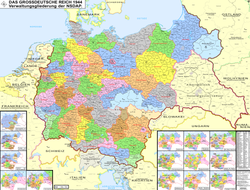Reichsgau Sudetenland
| Reichsgau Sudetenland | ||||||
| Gau of Nazi Germany | ||||||
|
||||||
|
||||||
|
Map of Nazi Germany showing its administrative subdivisions (Gaue and Reichsgaue). |
||||||
| Capital | Reichenberg | |||||
| Reichsstatthalter | ||||||
| • | 1939–1944 | Konrad Henlein | ||||
| History | ||||||
| • | Munich Agreement | 30 September 1938 | ||||
| • | Reichsgau established | 15 April 1939 | ||||
| • | German Instrument of Surrender | 8 May 1945 | ||||
| Today part of |
|
|||||
The Reichsgau Sudetenland was an administrative division of Nazi Germany from 1939 to 1945. It comprised the northern part of the Sudetenland territory, which was annexed from Czechoslovakia according to the 1938 Munich Agreement. The Reichsgau was headed by the Sudeten German activist Konrad Henlein in the rank of a Reichsstatthalter. The administrative capital was Reichenberg (Liberec).
In the course of the German occupation of Czechoslovakia, on 30 September 1938 the Heads of Government of the United Kingdom, France, Italy, and Germany signed the Munich Agreement, which enforced the cession of the Sudetenland to Germany. Czechoslovak representatives were not invited. On 1 October, invading Wehrmacht forces occupied the territory. The new Czechoslovak-German borders were officially fixed in a treaty on 21 November 1938. In consequence, the Czechoslovak Republic lost about one third of its population, its most important industrial area, and also its extended border fortifications.
Initially, the German Army (Heer) established a civil administration under occupational law. On 1 October 1938, Konrad Henlein was appointed Reichskommissar of Sudetenland; however he did not assume power until 20 October. The Sudeten German Party was merged into the Nazi Party, all other political parties were banned. The Czech population had to accept German citizenship or were expelled and forcibly relocated to the Czechoslovak rump state, which itself from March 1939 was occupied by Germany and incorporated as "Protectorate of Bohemia and Moravia".
...
Wikipedia



